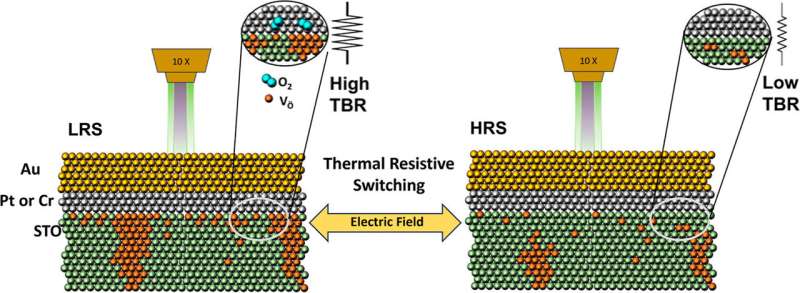This article has been reviewed according to Science X's editorial process and policies. Editors have highlighted the following attributes while ensuring the content's credibility:
fact-checked
peer-reviewed publication
proofread
Researchers show electrical pulses can control thermal resistance in devices

Controlling heat flow is key to enhancing performance in a wide variety of systems. In electronic devices, such as mobile phones or any type of processor, overheating decreases their performance and reduces their lifetime. All these technologies are based on materials with a certain resistance to the heat that flows through them.
Researchers at the Center for Research in Biological Chemistry and Molecular Materials (CiQUS) found that this thermal resistance in devices can be modulated by applying the appropriate voltage. The work is published in the journal ACS Applied Materials & Interfaces. Led by Rafael Ramos and Francisco Rivadulla, their findings pave the way for the design of thermal regulators and more efficient and sustainable technologies.
The development of new functional materials with tunable thermal conductivity offers solutions to challenges such as heat dissipation in electronic components. Among these devices of interest are memristors, a component with resistive switching effect: when an electric field is applied, the material can reversibly alternate between different levels of electrical resistance.
In the new study, the researchers showed that alongside electrical resistive switching, a thermal resistive switching effect also occurs at the metal-oxide interface of the material, due to the accumulation of oxygen ions. This alteration in heat flow resistance can be modulated by around 20% at room temperature.
"Oxides are materials with thermal resistance highly sensitive to oxygen concentration, so by inducing a displacement of these ions when an electric field is applied, we modify their thermal properties," explains Víctor Álvarez, a Ph.D. candidate at CiQUS and the study's lead author.
"Depending on the resistive state of the device, we've achieved a reversible increase or decrease in thermal conductivity with an electric field."
The research is part of the MEMTHERM project and aims to develop new thermoregulators based on controlling ion movement in dielectric oxides.
More information: Víctor Álvarez-Martínez et al, Interfacial Thermal Resistive Switching in (Pt,Cr)/SrTiO3 Devices, ACS Applied Materials & Interfaces (2024). DOI: 10.1021/acsami.3c19285




















